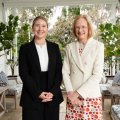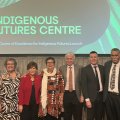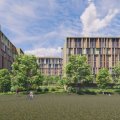A University of Queensland science undergraduate student is describing a new genus of Queensland fossil dragon lizard which became extinct 1.5 million years ago.
The lizard, found near Clifton, eastern Darling Downs, would have been a 'fairly vicious little animal with a mean appetite for insects', according to second-year bachelor of science student Scott Hocknull.
Mr Hocknull recently beat 30 postgraduate students to win the best student paper at the Conference on Australasian Vertebrate Evolution, Palaeontology and Systematics organised by the Western Australian Museum. Co-winner was Gavin Prideaux, a postgraduate at Flinders University.
Mr Hocknull's paper looked at fossil agamid lizards ('dragons') from the Darling Downs and other sites in south-east Queensland.
By studying skull bones of the fossil lizard, Mr Hocknull determined that it had features which distinguished it from all modern Tympanocryptis species except the distinctiveTympanocryptis lineata.
The new genus had reclined teeth which were used to shear its prey, tough insects such as dung beetles.
'It is possible that the extinction of its prey led to the demise of this little lizard,' Mr Hocknull said.
'The extinction of the megafauna, such as diprotodon and relatives during the Pleistocene period, from 10,000 to 1.8 million years ago, would have led to the extinction of small invertebrates that fed on their dung and carcasses.
'It would have have been a complex series of events which led to the dragon's extinction.'
Mr Hocknull, who is majoring in zoology and geology, has loved lizards since he was an eight year-old student at Larrakeyah Primary School, Darwin.
'I can thank the school janitor who took time to show us the lizards, frill-necked lizards and lace monitors in the school grounds,' he said.
'We went from being frightened that they would bite us to enjoying them.'
His interests broadened to fossils when his family moved to Queensland five years ago and he met the curator of vertebrate palaeontology at Queensland Museum, Dr Ralph Molnar, before starting at Kooralbyn International School.
Dr Molnar recruited Mr Hocknull as a volunteer at Queensland Museum to collect, prepare and catalogue specimens. He worked on invertebrates, particularly freshwater bivalves, and lizards and fossil dragons.
With the encouragement of Museum curator Dr Alex Cook, Mr Hocknull wrote his first scientific paper at the age of 16 and this was published in the Museum's Scientific Memoirs. The subject was a 215 million-year-old freshwater bivalve which Mr Hocknull collected at Ipswich.
'It was a bottom-dwelling scum sucker. Scientific protocol determines that you cannot name a species after yourself so I did the next best thing and named it Protovirgus clellandi after my father, whose middle name is Clelland,' he said.
'My father was somewhat amused. However, I do have a species partly-named after myself.
'Dr Cook found a gastropod from the Devonian period, 300 million years ago, in the Broken River region near Townsville. As another Museum volunteer, Paul Tierney and I are known as the ?Dodgey Brothers', Dr Cook called the gastropod Palaeozygopleura dodgeyi.'
In July this year Mr Hocknull published his second paper in the Museum's Memoirs on three new species of freshwater bivalves described from the Museum's own collections. The molluscs from the Cretaceous period 100-90 million years ago are Protovirgus wintonensis, Prohyria macmichaeli and Velesunio goondiwindiensis.
Mr Hocknull has identified dragons and skinks from eight fossil sites in south-east Queensland including Russendon Cave, Texas, Cement Mills, Gore and parts of the Eastern Darling Downs.
'All these species are extant, but there's a lot scientists don't know about them, including their previous geographic and age distribution,' he said.
'We need funding to continue the study of modern and prehistoric lizards in Australia, something that has been lacking.'
Mr Hocknull hopes to study science honours at the University of Queensland supervised by reader in zoology Dr Tony Thulborn who is co-supervising his independent science project work.
Media: For further information, contact Mr Hocknull, telephone 07 3844 2844.




